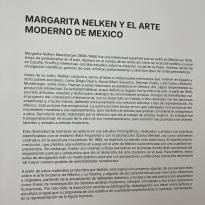In the heart of Madrid, Fundación Casa de México en España stands as a vibrant celebration of Mexican culture, offering locals and visitors a glimpse into the nation’s artistic and cultural treasures. On a recent visit, I had the opportunity to explore two standout exhibits: Arte Moderno de México and Belenes de México. Both exhibits highlight the diversity and richness of Mexican heritage, and as someone of Mexican descent, the experience resonated with me on a deeply personal level.
The Arte Moderno de México exhibit is a stunning showcase of 64 works drawn from the Blaisten Collection, one of the most renowned private collections of modern Mexican art. Walking through the gallery felt like stepping into a vibrant dialogue between some of Mexico’s most celebrated artists. The works of Diego Rivera, María Izquierdo, Dr. Atl, and Rufino Tamayo, among others, adorned the walls, each piece offering a distinct perspective on the evolution of Mexican modern art. The exhibit, curated by Daniel Garza Usabiaga, offers an innovative interpretation through the lens of Margarita Nelken, a Spanish intellectual who found refuge in Mexico during the Spanish Civil War. Her critiques of the institutionalization of certain art styles and her support for diversity in artistic expression added a layer of complexity to the exhibit, making it more than just a visual experience—it was a narrative of resilience, transformation, and cultural exchange.
One piece that particularly stood out to me was a painting by María Izquierdo, known for her bold use of color and exploration of themes related to femininity and tradition. Her work reminded me of the stories my abuelita would tell me about growing up in Mexico, where art often reflected everyday life and deeper societal shifts. Seeing these masterpieces in Madrid, a city known for its own rich artistic heritage, felt like a bridge between two parts of my identity—my Mexican roots and my current experience living in Spain.
After immersing myself in modern Mexican art, I stepped into a world of festive tradition with Belenes de México. This exhibit is a celebration of Mexican craftsmanship, featuring a central nativity scene crafted using the traditional technique of cartonería. The 34 figures, ranging from 50 to 100 centimeters tall, were striking not just for their vibrant colors but for their cultural depth. The figures represented characters from traditional Mexican dances—chinelos, tlacoleros, and quetzales—as well as musicians, angels, and the classic nativity figures of Mary, Joseph, and the Wise Men. The attention to detail in these figures was remarkable, from the intricate patterns on the costumes to the expressive faces that seemed to bring the characters to life.
What made this exhibit even more special were the smaller nativity sets from various regions of Mexico. Each one showcased a unique artistic technique, from carved volcanic stone to glazed clay and painted wood. One particularly delicate piece made from carved jícara (gourd) caught my eye, its intricate designs showcasing the incredible skill of the artisan. The exhibit also featured a striking four-meter-tall quiote, symbolizing a Christmas tree, and an arch of flowers crafted from totomoxtle (dried corn husks), visible from the street. These elements not only highlighted the creativity of Mexican artisans but also brought a sense of home to a place far from where these traditions originated.
For me, this visit was more than just a cultural outing—it was a moment of connection. Growing up with a Mexican heritage, I’ve always felt a deep pride in the vibrant art, traditions, and history of my culture. Experiencing these exhibits in Madrid allowed me to appreciate how Mexican art holds its own in a global context while also feeling a sense of belonging in a space dedicated to celebrating it. It also made me reflect on the art spaces I’ve encountered in Spain. Whether it’s the Prado’s old masters or the modernist works of Picasso, Spanish art has a grandeur that can feel intimidating. But here, in the Casa de México, I found a more intimate, welcoming environment where I could experience art not just as an observer but as someone connected to it through heritage and memory.
Walking through the Arte Moderno de México exhibit, I thought about how many of these artists were influenced by their own experiences of migration, political upheaval, and cultural identity. Margarita Nelken’s perspective as a Spanish exile in Mexico also struck a chord—it was a reminder of how art can transcend borders and become a universal language for expressing human experience. Similarly, Belenes de México was a celebration of the ways Mexican traditions have evolved while staying deeply rooted in community and craftsmanship.
For anyone in Madrid, Fundación Casa de México offers a unique opportunity to explore a different side of the city’s artistic landscape. Whether you’re drawn to the bold strokes of modern Mexican painters or the intricate details of nativity figures crafted by hand, there’s something here that will leave a lasting impression. For me, it was a reminder that art is more than what we see—it’s what we feel, and how it connects us to who we are.






Layla Santiago
An avid hiker and rookie musician, I love being outdoors and jamming on the guitar whether solo or with friends. Having Mixtec, Mexican, and Polish heritage has allowed me to appreciate diverse cultures and perspectives.













